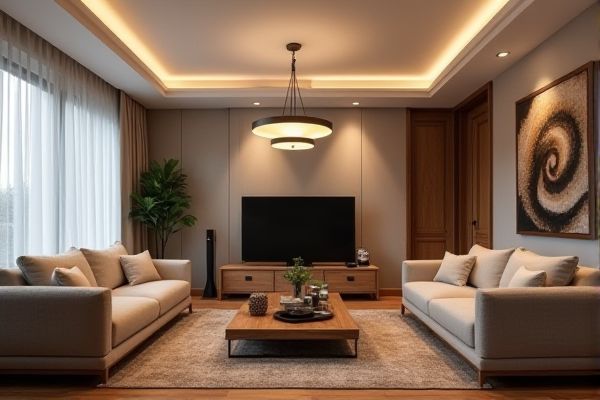
Recessed lighting provides a sleek, unobtrusive look ideal for ambient or task lighting, while pendant lighting offers a decorative focal point that adds character and style to your space. Explore the rest of this article to determine which lighting option best suits your design needs and enhances your room's functionality.
Table of Comparison
| Feature | Recessed Lighting | Pendant Lighting |
|---|---|---|
| Installation | Built into ceiling, requires wiring and ceiling access | Suspended from ceiling, easier to install if existing hook or junction box |
| Light Distribution | Even, ambient lighting with subtle effect | Focused, directional lighting often used as task or accent light |
| Style & Aesthetics | Minimalistic, modern, unobtrusive design | Decorative focal point with various styles and sizes |
| Ceiling Height Suitability | Ideal for low to standard ceilings | Best for high ceilings to avoid obstruction |
| Energy Efficiency | Compatible with LED bulbs for low energy use | Also supports LED bulbs but wattage varies by design |
| Maintenance | Less accessible, requires tools for bulb replacement | Easy to clean and bulbs easy to replace |
| Common Applications | General lighting in kitchens, living areas, offices | Task lighting over islands, dining tables, entryways |
Introduction to Recessed and Pendant Lighting
Recessed lighting is installed into the ceiling, offering a sleek, unobtrusive illumination ideal for creating ambient or task lighting without occupying visual space. Pendant lighting hangs down from the ceiling, becoming a focal point that provides direct, stylish illumination suitable for dining areas or kitchen islands. Both lighting types serve distinct design purposes, balancing functionality and aesthetic appeal in modern interiors.
Key Differences Between Recessed and Pendant Lighting
Recessed lighting offers a sleek, minimalist look by being installed flush with the ceiling, providing ambient or task lighting without occupying visual space. Pendant lighting hangs down from the ceiling, making it a focal point while offering directional illumination ideal for dining areas or kitchen islands. Your choice depends on whether you prioritize subtle, integrated light or decorative, statement fixtures.
Aesthetic Impact: Modern vs. Decorative Appeal
Recessed lighting offers a sleek, modern aesthetic by seamlessly integrating into ceilings for a minimalist and unobtrusive look, ideal for contemporary spaces emphasizing clean lines and simplicity. Pendant lighting provides a decorative appeal with its varied designs, colors, and shapes, serving as a focal point that enhances room character and adds visual interest through suspended fixtures. Choosing between recessed and pendant lighting depends on desired ambiance: recessed for subtle sophistication, pendant for statement-making style.
Lighting Performance and Coverage
Recessed lighting offers uniform light distribution with minimal shadows, ideal for overall room illumination and creating a clean, modern look. Pendant lighting delivers focused, directional light that enhances specific areas or tasks, making it perfect for kitchen islands or dining tables where concentrated brightness is needed. Choosing between the two depends on whether you want broad lighting coverage or targeted illumination to optimize your space's functionality.
Space and Ceiling Height Considerations
Recessed lighting is ideal for low ceilings or small spaces as it provides unobtrusive illumination without occupying visual or physical space. Pendant lighting works best in rooms with higher ceilings, offering focused light while creating a decorative statement. Ceiling height of 8 feet or less favors recessed lights, whereas ceilings above 9 feet can accommodate various pendant styles for enhanced ambiance.
Energy Efficiency and Bulb Options
Recessed lighting offers enhanced energy efficiency with options for LED bulbs that consume less power and last longer, making them ideal for sustained use. Pendant lighting provides more versatility in bulb types, including LEDs and smart bulbs, allowing customizable brightness and color temperature tailored to your space. Choosing between the two involves balancing the discreet, energy-saving benefits of recessed lights against the flexible and decorative bulb choices available in pendant fixtures.
Installation Complexity and Costs
Recessed lighting requires cutting precise holes in ceilings and professional electrical work, often resulting in higher installation complexity and costs compared to pendant lighting. Pendant lights typically involve simpler mounting to existing electrical boxes with adjustable cords or rods, making them more cost-effective and easier to install in most settings. Budget-conscious homeowners may prefer pendant lighting for straightforward installation, while recessed lighting suits those seeking a sleek, integrated look despite the added expense.
Maintenance and Longevity Comparison
Recessed lighting fixtures generally require less maintenance due to their encased design, which protects bulbs from dust and damage, extending their lifespan significantly compared to pendant lighting. Pendant lights have exposed bulbs and components that may need frequent cleaning and occasional bulb replacement, increasing upkeep efforts. The longevity of recessed lighting is enhanced by energy-efficient LED options that reduce heat output and prolong fixture durability.
Best Rooms and Applications for Each Type
Recessed lighting is ideal for kitchens, bathrooms, and hallways where a clean, streamlined look and even illumination are essential for task lighting and ambient light. Pendant lighting works best in dining rooms, kitchens over islands, and living rooms, providing focused light while serving as a decorative element to define spaces. Combining recessed and pendant lighting enhances both functionality and style, adapting to varied lighting needs in residential and commercial interiors.
Choosing the Right Lighting for Your Space
Recessed lighting offers a sleek, unobtrusive design ideal for low ceilings and ambient illumination, enhancing room brightness without visual clutter. Pendant lighting serves as a focal point, providing task lighting and decorative appeal, perfect for dining areas and kitchen islands. Opt for recessed lights to maximize ceiling height and uniform light distribution, while pendant fixtures add character and direct light where needed.
 homyna.com
homyna.com